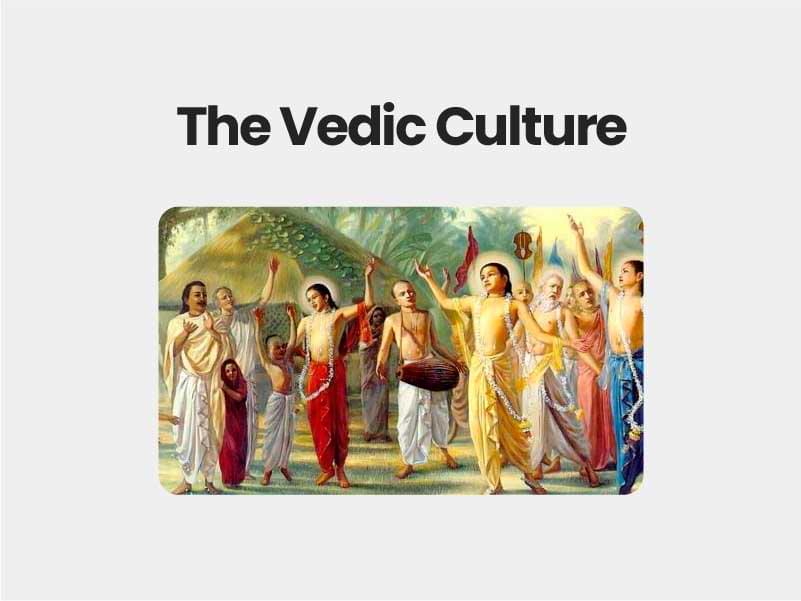Companion@360 → 7 Month programme to sharpen your writing skills → REGISTER NOW

The Vedic Culture
Around thisvedic culture period, the speakers of the Indo-Aryan language, Sanskrit, entered north-west India from the Indo-Iranian region. As they were mainly cattle keeping people, they were mainly in search of pastures. By 6th century B.C., they occupied the whole of North India, which was referred to as Aryavarta
- Vedic Literature
The word ‘Veda’ is derived from the root ‘vid’, which means to know
- the term ‘Veda’ signifies ‘superior knowledge’
- Vedic literature consists of the four Vedas – Rig, Yajur, Sama and Atharva.
- Rig Veda is the earliest of the four Vedas and it consists of 1028 hymns.
- The hymns were sung in praise of various gods.
- Yajur Veda consists of various details of rules to be observed at the time of sacrifice
- Sama Veda is set to tune for the purpose of chanting during sacrifice.
- It is called the book of chants and the origins of Indian music are traced in it.
- The Atharva Veda contains details of rituals.
- Besides the Vedas, there are other sacred works like the Brahmanas, the Upanishads, the Aranyakas and the epics Ramayana and Mahabharata
- Brahmanas are the treatises relating to prayer and sacrificial ceremony
- Upanishads are philosophical texts dealing with a topic like a soul, the absolute, the origin of the world and the mysteries of nature.
- Aranyakas are called forest books and they deal with mysticism, rites, rituals and sacrifices
Rig Vedic Age or Early Vedic Period (1500 – 1000 B.C.)
- During the Rig Vedic period, the Aryans were mostly confined to the Indus region
- Rig Veda refers to Saptasindhu or the land of seven rivers
- includes the five rivers of Punjab, namely Jhelum, Chenab, Ravi, Beas and Sutlej along with the Indus and Saraswathi.Buddhism
Political Organization
- the basic unit of political o RG–kula or family
- Several families joined together on the basis of their kinship to form a village or grama
- leader of grama was known as gramani
- A group of villages constituted a larger unit called visu.
- It was headed by vishayapati.
- the highest political unit was called Jana or tribe.
- several tribal kingdoms during the Rig Vedic period such as Bharatas, Matsyas, Yadus and Purus.
- head of the kingdom was called as Rajan or king
- monarchical and the succession was hereditary.
- king was assisted by purohita or priest and senani or commander of the army in his administration. were two popular bodies called the Sabha and Samiti
- former seems to have been a council of elders and the latter, a general assembly of the entire people.
Social Life
- Rig Vedic society was patriarchal.
- head of the family was known as grahapathi.
- Monogamy was generally practised while polygamy was prevalent among the royal and noble families
- The wife took care of the household and participated in all the major ceremonies.
- Women were given equal opportunities as men for their spiritual and intellectual development.
- women poets like Apala, Viswavara, Ghosa and Lopamudra during the Rig Vedic period.
- Women could even attend the popular assemblies.–Samiti
- no child marriage and the practice of Sati was absent. –
- Both men and women wore upper and lower garments made of cotton and wool
- Wheat and barley, milk and its products like curd and ghee, vegetables and fruits were the chief articles of food.
- eating of cow’s meat was prohibited since it was a sacred animal
- . Chariot racing, horse racing, dicing, music and dance were the favourite pastimes
- social divisions were not rigid during the Rig Vedic period as it was in the later Vedic period.
Economic Condition
- pastoral people and their main occupation was cattle rearing.
- wealth was estimated in terms of their cattle
- With the knowledge and use of iron, they were able to clean forests and bring more lands under cultivation.
- Carpentry was another important profession and the availability of wood from the forests cleared made the profession profitable
- Workers in metal made a variety of articles with copper, bronze and iron
- Spinning was another important occupation and cotton and woollen fabrics were made
- Goldsmiths were active in making ornaments.
- The potters made various kinds of vessels for domestic use.
- Trade was conducted on the barter system.
- rivers served as important means of transport.
- In the later times, gold coins called nishka were used as media of exchange in large transactions.
Religion
- worshiped the natural forces like earth, fire, wind, rain and thunder.
- personified these natural forces into many gods and worshipped them
- important Rig Vedic gods were Prithvi (Earth), Agni (Fire), Vayu (Wind), Varuna (Rain) and Indra (Thunder).
- Indra was the most popular among them during the early Vedic period
- Agni who was regarded as an intermediary between the gods and people
- Varuna was supposed to be the upholder of the natural order.
- There were also female gods like Aditi and Ushas.
- were no temples and no idol worship during the early Vedic period
- Prayers were offered to the gods in the expectation of rewards
- Ghee, milk and grain were given as offerings.
Later Vedic Period (1000 – 600 B.C.)
- Aryans further moved towards the east in the Later Vedic Period.
- Satapatha Brahmana refers to the expansion of Aryans to the eastern Gangetic plains
- Kuru and Panchala kingdoms flourished in the beginning
- Janaka was the king of Videha with its capital at Mithila. His court was adorned by scholar Yajnavalkya.
- Magadha, Anga and Vanga seem to be the easternmost tribal kingdoms.
- The later Vedic texts also refer to the three divisions of India –
- Aryavarta (northern India),
- Madhyadesa (central India) and
- Dakshinapatha (southern India).
Political Organization
- Larger kingdoms
- Many Jana or tribes were amalgamated to form janapadas or rashtras in the later Vedic period.
- The king performed various rituals and sacrifices to strengthen his position.
- Rajasuya (consecration ceremony),
- Asvamedha (horse sacrifice) and
- Vajpeya (chariot race).
- kings also assumed titles like Rajavisvajanan, Ahilabhuvanapathi, (lord of all earth), Ekrat and Samrat (sole ruler).
- new officials were involved in the administration
- They include the treasury officer, tax collector and royal messenger.
- lower levels, the administration was carried on by the village assemblies.
- importance of the Samiti and the Sabha had diminished during the later Vedic period.
Economic Condition
- Iron was used extensively in this period and this enabled the people to clear forests and to bring more land under cultivation.
- Agriculture became the chief occupation
- barley, rice and wheat were grown
- Knowledge of manure
- Industrial activity became more varied and there was greater specialization.
- Metalwork, leatherwork, carpentry and pottery made great progress
- addition to internal trade +, foreign trade became extensive.
- Later Vedic people were familiar with the sea and they traded with countries like Babylon
Guild
- class of hereditary merchants (vaniya) came into existence
- Vaisyas also carried on trade and commerce
- They organized themselves into guilds known as ganas
- Besides nishka of the Rig Vedic period, gold and silver coins like satamana and Krishnala were used as media of exchange
Social Life
- four divisions of society (Brahmins, Kshatriyas, Vaisyas and Sudras) or the Varna system was thoroughly established
- the power of the father increased
- no improvement in the status of women.
- still considered inferior and subordinate to men. Women also lost their political rights of attending assemblies.
- Child marriages had become common.
- According to the Aitreya Brahmana, a daughter has been described as a source of misery.
Religion
- Gods of the Early Vedic period like Indra and Agni lost their importance.
- Prajapathi (the creator), Vishnu (the protector) and Rudra (the destroyer) became prominent
- Sacrifices were still important and the rituals connected with them became more elaborate
- importance of prayers declined and that of sacrifices increased
- The priesthood became a profession and a hereditary one
- formulae for sacrifices were invented and elaborated by the priestly class. Therefore, towards the end of this period, there was a strong reaction against priestly domination and against sacrifices and rituals.
- rise of Buddhism and Jainism was the direct result of these elaborate sacrifices
- the authors of the Upanishads, which is the essence of Hindu philosophy, turned away from the useless rituals and insisted on true knowledge (jnana) for peace and salvation.
Jainism And Buddhism
- In India, the republican institutions were strong in the 6th century B.C.This enabled the rise of heterodox sects against the orthodox religion dominated by rites and ritual Causes for the Rise of Jainism and Buddhism
- the primary cause for the rise of Jainism and Buddhism was the religious unrest in India in the 6th century B.C
- rituals and sacrifices advocated in the Later Vedic period were not acceptable to the common people
- sacrificial ceremonies were also found to be too expensive.
- superstitious beliefs and mantras confused the people
- teachings of Upanishads, an alternative to the system of sacrifices, were highly philosophical in nature and therefore not easily understood by all
- larger interests of the people was a simple, short and intelligible way to salvation for all people.
- language is known to them
- need was fulfilled by the teachings of Buddha and Mahavira.
- economic factors also contributed to the rise of these two religions.
- The rigid caste system prevalent in India generated tensions in the society
- Eg: Kshatriyas had resented the domination of the priestly class.
- Buddha and Mahavira belonged to Kshatriya origin
- growth of trade led to the improvement in the economic conditions of the VaisyaAs a result, they wanted to enhance their social status but the orthodox Varna system did not allow this.
- Therefore, they began to extend support to Buddhism and Jainism. It was this merchant class that extended the chief support to these new religions

